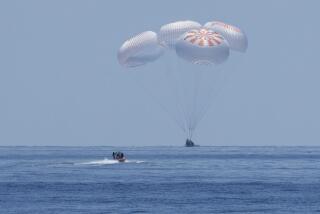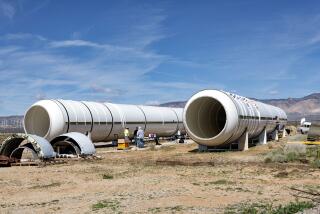Soviet Lawmakers to Tour S.D. Defense Sites : Military: The first-hand look at U.S. facilities won’t be the only peaceful Soviet invasion. Three Soviet warships are expected to visit the city this summer.
Reciprocating a visit from a congressional committee, a group of Soviet defense lawmakers will visit several military installations throughout the United States next week, spending three days in San Diego.
Ten members of the Supreme Soviet Committee on Defense and State Security and their entourage will arrive in Washington Feb. 7 for an 11-day visit. Their trip comes after the visit of the House Armed Services Committee to the Soviet Union last August.
“We learned a great deal about the Soviet Union from our trip there last summer,” said Rep. Les Aspin (D-Wis.), chairman of the Armed Services Committee. “We hope to offer an equal chance for better understanding between our two countries during this visit.”
The Soviet lawmakers, members of the newly formed defense committee of the Soviet legislature, will watch a meeting of the Armed Services Committee on Feb. 8. The next day, the group of about 30 will travel to Santa Fe, N.M. On Feb. 10, they arrive in San Diego to tour Miramar Naval Air Station, North Island Naval Air Station and the Marine Corps Recruit Depot. The dignitaries will probably squeeze a visit to the San Diego Zoo into their schedule, too, probably Feb. 11.
Aspin, 14 congressmen, and a delegation of experts visited the Soviet Union and East Germany on a 12-day trip that allowed an unprecedented tour of military installations. Their travels included the first visit by foreigners to an operational intercontinental ballistic missile launch control center. And U.S. officials are also expected to return the favor with a similar degree of openness.
“That was a ground-breaking visit,” said Ted Warner, a senior defense analyst for Rand Corp. who traveled with Aspin’s group.
The reciprocal visit paid by next week’s delegation, Warner said, is particularly important because of the tremendous changes sweeping the Soviet Union.
“We have for the first time a parliamentary institution that seems to have real power to play a significant and meaningful role--not just a rubber stamp,” Warner said. “We are trying to develop an ongoing pattern of cooperation between Congress and this new and potentially important Soviet legislative body.”
Next week’s visit will be the first this year by a Soviet delegation to San Diego, a city usually deemed off limits. Soviet officials are permitted in three cities: Washington, New York and San Francisco, where they maintain an embassy and consuls. Officials are not permitted to travel more than 30 miles from each city, according to the Federal Bureau of Investigation.
The Soviets are also expected to sail three of their Navy warships to San Diego this July, the first such visit to a military installation on the West Coast. Last July, three ships with 1,100 sailors visited the Norfolk Naval Station in Virginia on a “friendship call,” the Soviets’ first visit to the Navy’s largest port in more than 100 years.
To reciprocate the Soviets’ visit to Norfolk, the Navy dispatched three ships to the Black Sea port of Sevastopol in the Crimea last August. It is not yet known whether the Navy will send another crew of ships to the Soviet Union to reciprocate the San Diego visit expected this summer.
“It’s true the Soviets are coming. They are coming with an olive branch and not a nuke in their hands,” said retired Rear Adm. Gene R. La Rocque, director of the Center for Defense Information in Washington. “It’s further evidence that not only the Cold War has ended, but we are moving to an era of understanding and friendship with the Soviet Union.”
The Soviet tour will include Petersen Air Force Base in Colorado; Ft. Hood and an F-16 Fighting Falcon plant in Texas; Navy facilities in Virginia; a chemical plant in Alabama and the NASA Space Center in Florida.
More to Read
Get the L.A. Times Politics newsletter
Deeply reported insights into legislation, politics and policy from Sacramento, Washington and beyond. In your inbox three times per week.
You may occasionally receive promotional content from the Los Angeles Times.










